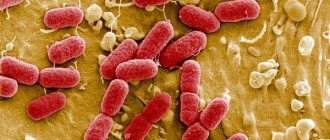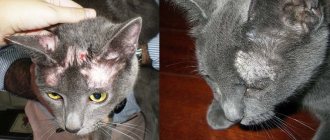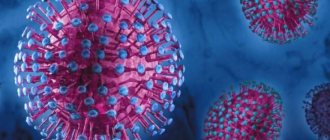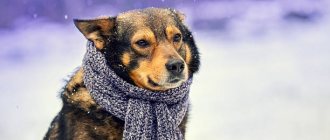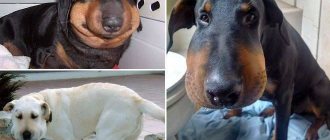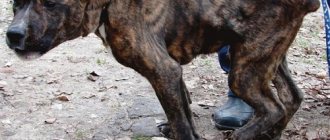Canine coronavirus, what is it
Coronavirus is a type of infection with spike-like processes on the membranes like a crown. The causative agent is a virus of the Coronaviridae family containing RNA. The form of the disease, taking into account the area of infection, proceeds as follows:
- respiratory type of cold, pneumonia;
- intestinal with dysfunction of the gastrointestinal tract, symptoms of acute enteritis.
The new coronavirus is highly contagious:
- affects the heart, respiratory organs;
- provokes exhaustion, dehydration, inflammation of the gastrointestinal tract;
- can cause irreparable harm to the animal’s body, including death in the absence of timely treatment.
Additional Information! The first case of coronavirus was recorded in a dog in Hong Kong with a weak positive result. The virus is believed to be transmitted from an infected host. There are no symptoms of the disease. But samples from the mouth and nose taken for testing confirm the fact of infection. The animal is placed in a special room where it will be observed by doctors for 2 weeks.
Symptoms of infection in children
In young children, the disease is usually mild and without significant symptoms. The threat is that babies can infect older relatives who are at risk. Therefore, it is extremely important to identify the virus in children in time and minimize the child’s contact with grandparents.
Newborns may exhibit nonspecific symptoms such as monotonous crying, trouble sleeping, restlessness, poor appetite, and lethargy. Obvious signs of coronavirus infection are the appearance of intestinal colic, the presence of which is indicated by a bloated tummy, upset bowel movements, and insomnia. Body temperature can be 37.5-38 degrees. Dangerous symptoms include vomiting throughout the day, which can lead to dehydration.
In children aged 5-8 years, symptoms of Covid-19 may include the following:
- increased body temperature;
- headache;
- decreased appetite, activity;
- increased fatigue;
- the appearance of a rash;
- a sore throat.
In isolated cases, difficulty breathing may occur.
Body temperature usually does not exceed 38.5 degrees. Children, unlike adults, tolerate viral infections much easier.
Routes of infection
There are 3 known ways of transmitting enteritis to dogs:
- Airborne - a respiratory form of infection through direct contact with mucus from the sinuses.
- Drinking water or eating feces contaminated with the virus.
The virus is persistently colonized. It rushes in all ways into the epithelium of blood vessels and the walls of the small intestine. It penetrates into cells, creates copies of itself, provokes damage to internal organs, damage to the mucous membranes with the spread of foci of necrosis or erosive formations.
The duration of the incubation period is 8-10 days. It is around this time from the time of infection that the dog begins to show obvious symptoms. The risk group consists of young puppies under 5 months with weakened immune systems, also living in shelters.
Reference! Puppies are having a hard time surviving the new Wuhan coronavirus. Although mutations are unlikely. Owners should not worry about cross-contamination. Is coronavirus in dogs transmitted to humans? The answer is no. This is exclusively a canine virus. Also does not apply to other animals in the house. For example, cats.
Characteristics of the disease
Canine coronavirus (CCV, Canine Coronavirus) is somewhat related to feline coronavirus and can become a source of infection for the feline family. When a coronavirus infection is detected in dogs, it is advisable to isolate the sick individual from other pets in a separate room.
Coronavirus infection (Coronaviruses) is ubiquitous; antibodies to the disease are found in 55-60% of dogs at home. When examining animals kept in enclosures, coronavirus is diagnosed in 100% of cases in dogs of all ages and breeds.
The virus is transmitted through the fecal-oral route (feces, nasal mucus, cough). Sources of infection are sick animals with obvious clinical signs and virus carriers with a latent course of the disease.
Experts doubt the role of coronavirus as the primary pathogen capable of causing the disease, although it is isolated from sick animals. Coronavirus enteritis in a puppy is often positioned as a secondary pathogen.
The virus penetrates the structure of the cells of the mucous membrane of the thick and thin sections of the gastrointestinal tract, partially affecting nearby lymph nodes, but this does not have much significance in the disease.
The incubation period is from 1 to 7 days. After introduction into the body, the virus begins to actively release into the external environment after 14-16 days; on the 5th day of infection, antibodies that kill the virus are detected in the blood.
Dogs at risk for CCV include dogs with reduced immunity, those who have suffered stress, and those kept in inappropriate conditions.
How does coronavirus manifest in dogs?
In young puppies up to 2 months old, an acute or hyperacute intestinal form of coronavirus is observed. Signs:
- refusal to eat;
- weakness, apathy;
- pallor of the mucous membrane of the mouth;
- dehydration, loss of fluid;
- intoxication;
- fast weight loss;
- high temperature up to +41 degrees;
- uncontrollable vomiting;
- passing watery stools with a pungent odor of a greenish, yellowish-orange hue.
In adult pets, the disease often has a hidden course. Symptoms do not appear clearly. But stool disorder periodically flares up. The animal becomes passive and loses weight. Begins to sneeze and cough with respiratory symptoms.
Usually the course of the disease is mild, like a cold. Although in the case of a bacterial infection, pneumonia, pneumonia, and even death may begin to develop. The main thing is not to miss this moment. The hyperacute stage of coronavirus in dogs progresses especially. Treatment in case of severe vomiting or loose diarrhea should be started immediately.
Respiratory damage
Denoted by the abbreviation RCoV, it was first identified at the beginning of the 21st century and does not have a dangerous course. It is transmitted by coughing and sneezing in puppies and adult animals. This “cog” in the complex of infections is united by veterinarians into the pathology group “kennel cough in dogs.”
During the examination, herpes, adenovirus, parainfluenza, mycoplasmosis, streptococcus, and bordetellosis are found.
The symptoms of the respiratory form of coronavirus are similar to ARVI, but are not diagnosed as a single disease.
The reservoir of the virus is sick animals, they must be quarantined, and the room where they were is disinfected. People caring for dogs become carriers of RCoV; the virus can be on their hands, shoes, or clothes.
Coronavirus in puppies and dogs from one year onwards manifests symptoms:
- Discharge from the nose (catarrhal, purulent).
- Sneezing;
- Cough.
Fever is a rare symptom associated with the addition of bacterial microflora or complication of RCoV pneumonia. Dogs with strong immunity look healthy outwardly, but actively release the virus into the external environment.
There is no exact time frame for the latency period for RCoV. In fact, it takes 2-3 days for the respiratory form of coronavirus to develop. The mild course of the disease ends within 7-14 days.
Treatment options for RCoV have not been determined. No specific antiviral therapy has been developed; symptoms are often relieved, alleviating the dog’s condition and minimizing the spread of the virus within the flock.
Antibiotics are effective for complications (pneumonia, etc.), the dog is isolated for up to 3 weeks, and, if necessary, placed in a hospital in a separate box.
How to treat coronavirus in dogs
No specific therapy is provided. The primary goal is to relieve unpleasant symptoms and help strengthen and enhance immunity. For weakened pets, a diet is recommended to restore the function of internal organs.
If the respiratory form of coronavirus does not progress, then quarantine is introduced for up to 3 weeks. The animal is isolated from healthy pets.
Shown:
- immunomodulators;
- vitamin complexes;
- sorbents for severe intoxication;
- antispasmodics to relieve spasms and pain;
- drips with saline solution for signs of dehydration;
- hemostatic agents for hemorrhagic gastroenteritis;
- antibiotics in case of bacterial infection.
With enteritis, polyvalent serum helps well to increase the immunity of the four-legged animal.
Routes of transmission and causes of the disease
Knowing how Covid can be transmitted to dogs, you need to take the necessary measures to prevent the disease from occurring.
The infection is transmitted in several ways:
- close contact with a sick dog - during sniffing;
- contact with feces - the grass may be soiled, an animal nearby licked its fur and licked something that a person could touch, and then the virus will appear in the house.
Basically, the virus appears in the animal’s body from dirty water and food, in windy weather with dust containing feces. Virologists are inclined to believe that if an animal has had coronavirus, its feces can be infectious for another six months after recovery. The version that the infection enters the DNA of intestinal cells and can begin to develop at any time under unfavorable conditions is also true.
Important! A sick dog sheds the infection in its feces for 15 days, most of it on the 6th day of infection.
How does coronavirus infection occur?
Covid of the intestinal type is transmitted from one animal to another through direct contact (sniffing, playing together, etc.), as well as through the feces of an infected dog (sometimes dogs get dirty in the feces of the disease carrier or even eat them), contaminated food and other products. Respiratory spread only through airborne droplets; animals living in nurseries are most susceptible to it.
Will the dog get sick again? No, antibodies to the pathogen will be present in the blood throughout your life.
Is there a vaccine for coronavirus?
A vaccine has been developed for dogs. Although there is no need to vaccinate against coronavirus. A pet cannot become infected with the human virus, just as the dog strain of CCV cannot be transmitted to people.
If the immune system is strong, then the animal recovers quickly. Weak puppies and young animals are more unstable. The mortality rate reaches 95%, especially in puppies from a shelter with a hyperacute course of the disease. The danger flares up in the first 2-4 days from the onset of the pathology.
Possible complications due to reduced immunity: pneumonia, parvovirus, plague. In hyperacute cases of the disease, accompanied by dehydration, cardiac arrest may occur.
It is extremely important for owners to get vaccinated before letting their pet go outside. If your dog is diagnosed with coronavirus and develops unpleasant symptoms, you should immediately show it to a veterinarian.
Unfortunately, a dog that has recovered from the virus remains a carrier for the rest of its life. If infection cannot be avoided, then when caring for a sick animal, it is important to disinfect the room and observe personal hygiene measures. When answering the question, can dogs spread COVID-19? Yes, it is transmitted. Sick animals are isolated from healthy ones. Symptomatic treatment is carried out.
What to do if your dog has been in contact with a coronavirus patient
If your four-legged friend has been in contact with someone who has COVID-19, you should not immediately contact a specialist. Initially, you need to bathe the animal in warm water with all precautions: wear gloves, goggles and a mask. After the procedure, immediately wash your clothes and take a quick shower. These measures will be sufficient.
But if the first symptoms of the virus appear, you should immediately contact a veterinary clinic. There they will conduct an examination, engage in diagnostics, and on the basis of this they will make an accurate diagnosis.
Prevention
Every pet owner can protect their dog from coronavirus infection; to do this, you must follow certain rules:
- Vaccinate dogs once a year;
- Keep your pet's habitat clean;
- Try to prevent your pet from coming into contact with the feces of other dogs;
- Monitor the animal’s health and strengthen its immunity (daily physical activity, taking vitamins and minerals, balanced feeding);
- If you suspect an infection, try to isolate sick animals from healthy ones.
Coronavirus in dogs is a very common infection among pets. Only careful care of your pet, timely vaccination and qualified veterinary care in case of infection with the virus can give your dog health and joy for many years to come.
Other preventive measures
To protect your beloved pet, it is important to regularly clean the premises using disinfectants. Don't forget to wash bowls and beds.
While walking, avoid unfamiliar animals and prevent attempts to sniff feces and wallow on the ground. Teach your dog basic inhibition commands to prevent any unwanted behavior.
To boost immunity, use high-quality food or vitamins recommended by a veterinarian. Don't forget about regular activity to stay in good physical shape.
If all recommendations are followed, the likelihood of developing the disease is minimal. To detect infection in a timely manner, pay attention to any deviations in your pet’s behavior. Loss of usual playfulness and appetite is a reason for examination. Don't be afraid to be wrong in your guesses. This is much better than asking for help too late.
Which breeds are more susceptible than others?
Animals of all breeds and ages are susceptible to the disease. However, puppies under 5 months of age are most susceptible to it when dogs are kept in groups.
How to protect your pet
The main prevention of coronavirus in dogs involves mandatory vaccination, which helps to develop immunity before meeting the real pathogen. All other recommendations are aimed at increasing immunity and preventing external causes of infection.
How to prevent your pet from becoming infected?
First of all, experts recommend eliminating close contact between humans and domestic animals and between animals in areas of infection. If a pet owner is sick with COVID-19 or suspects he has the infection, he needs to limit contact with pets or other animals. You should not pet your pet, hold him close, share food with him, or allow him to lick his sick owner.
It is also necessary to observe hygiene rules. This is mandatory hand washing before and after being near an animal, handling it or its food. It is advisable, if possible, to ensure that during illness, four-legged pets are cared for by a healthy family member.

